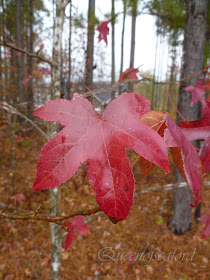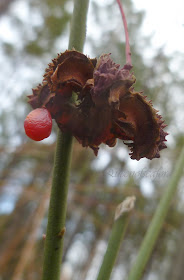Yesterday was South Carolina's Arbor Day. Last year I went up to USC Upstate's campus in Spartanburg for their celebration, the speaker was Dr. Michael Dirr. I enjoyed it and decided to come back each year!! I went up this year with a couple Master Gardeners from my area. This year's speaker was Tracy DiSabato-Aust. I know her books from reading many of your posts about her recommendations for tending to the perennial garden. Her program topic was "The Well-Designed Mixed Garden".
Tracy started off with some very clear expectations... first and foremost, no zone denial! What? Not me, I live in zone
After getting us on board to work within our zonal limits, Tracy took us through the steps in the design process.
Site evaluation seems pretty straight forward, check how many hours of sunlight you have, soil test, and of course, know your hardiness zone. You must then determine your objectives for this garden spot. Points to consider include
- maintenance- how much work do you do in the garden?
- budget- how much are you going to spend?
- location of the garden-private or public spaces?
- function- how are you going to enjoy your garden?
- peak season of interest-- I am working on getting more seasons of interest
- what is your style? What inspires you?
She spoke of scale and proportion. Scale is the size of an element or area and proportion is the relationship of the elements' size to each other -- a ratio of one dimension to another. (I didn't know we were going to have math!) She spoke of the Golden Mean, which is 1:1.618, also called the proportion of divine beauty. I understand using odd numbers of plants and when picturing a space that you don't want to divide it in half, use 1/3 2/3. This takes it a little further. When graphed, a series of numbers that have the Golden Mean ratio, form a perfect spiral. It is found in nature, a spiral shell, the arrangement of sunflower seeds, the way rose petals shape a bud. Read more about this here. Wow, more math than I have done in a long time. Tracy says to use the ratio in size, plant choice, color selection, textures and placement of plants. It will be more pleasing to the eye.
Color is another focus of design. She covered hue, value and intensity of color. Hue is pure color. Value is degree of luminosity (how much light is reflected back) and intensity is colorfulness or grayness or a color. Choosing colors takes control, I love so many colors. My last post shows how I needed to have a better plan for the colors in the front garden. Colors next to each other on the color wheel, analogous colors and colors opposite each other, complementary colors work can create harmony or cause the eye to stop. You can choose color schemes that are analogous, complementary monochromatic (one basic color in various shades and tones) or polychromatic- many colored.
Other elements of design include form-- you know, all those shapes (more math- Geometry) and texture-- fine, average and bold. One technique for seeing form in your garden is digital photography...using the black and white feature or the pencil line drawing feature. It eliminates the color your eye is drawn to, seeing form. The Golden Mean is used with texture, keeping that balance. I remember in my Virginia garden I ended up with too many spikey plants, too many spires. It was out of balance.
The design principles Tracy follows are Order, Unity, and Rhythm. Order in balance and mass plantings. Unity with dominance, repetition and interconnection- plants that mingle. Rhythm in color, textures, plantings... repetition, alternating, and gradation (color or size).
Color, form or texture can be achieved using art in the garden. Tracy likes to add some art to bring in a color or create a focal point or repeat a shape. You can personalize your garden with art.
I hope to keep and use some of these principles in my garden. It was such an informative program. I have barely covered all that Tracy shared.
Immediately after the program I met up with my buddy Julie from Growing Days. Julie lives close by but this is the first we have seen each other since the Spring Fling. It was great to visit over lunch. Julie suggested that my Master Gardener buddies and I stop by Hatcher Gardens on our way home. What a great recommendation. It is a 10 acre garden and Woodland Preserve. The Hatchers worked this garden, adding acreage over the years, making a slice of heaven out of a weedy trashy portion of land. I hope to get back to this garden many times over the seasons. It was truly a labor of love.
I will leave you with photos of our short time in the garden. Thanks for sticking around for these four years.
 |
| Pitcher plants in clay chimney inserts |
 |
| See the little hairs on the throat of the flower? |
 |
| Hillside of Oakleaf Hydrangeas |
 |
| Hand made bird feeders adorned the trees |
 |
| Various conifers created a beautiful setting |
 |
| Honey bees on Fatsia blooms |
 |
| Water features throughout the garden, filtering storm water |
 |
| Pretty pink Camellia |
 |
| Honey bees were all over the Mahonia blooms |
 |
| More pathways to explore next time. What a tranquil setting. |
Thanks for giving us directions to this wonderful garden Julie. I look forward to seeing it in all seasons.
I bought Tracy's book "The Well Tended Perennial Garden". Will share what I learn once I read through it. Stay tuned!
©Copyright 2012 Janet. All rights reserved. Content created by Janet for The Queen of Seaford.











































